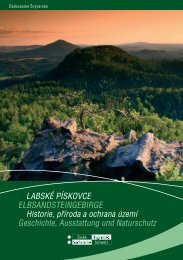ABSTRACT BOOK Sandstone Landscapes ... - Sandstones.org
ABSTRACT BOOK Sandstone Landscapes ... - Sandstones.org
ABSTRACT BOOK Sandstone Landscapes ... - Sandstones.org
Create successful ePaper yourself
Turn your PDF publications into a flip-book with our unique Google optimized e-Paper software.
PRichard Přikryl 1 , Jiřina Svobodová 2 and Petr Siegl 21 Institute of Geochemistry, Mineralogy and Mineral Resources, Faculty of Science, Charles University inPrague, Albertov 6, CZ-128 43 Prague 2, Czech Republic (prikryl@mail.natur.cuni.cz)2 School of Art Restoration, Academy of Fine Arts in Prague, U akademie 4, CZ-170 22 Prague 7, CzechRepublic (svobodj@avu.cz)Dimension stones from the “sandstone” areas in the Czech Republic<strong>Sandstone</strong>s are understood as any clastic sedimentary rock in technical practice. These rocks of Palaeozoicto tertiary age occupy more than 1/4 of the territory of the Czech Republic. The extensive exploitation ofsandstones since medieval times (probably Gothic) significantly influenced Czech architecture andsculpture and, for sure, sandstone landscapes as well.This contribution gives overview of important “sandstone” areas in the Czech Republic. The basicproperties and uses of selected stone types are presented together with their perspective application. Theinfluence of sandstone exploitation on landscape evolution is discussed mainly in the case of the BohemianCretaceous Basin.TD.A.Robinson and R.B.G.WilliamsCentre for Environmental Research, University of Sussex, Brighton BN1 9QJ, United Kingdom (D.A.Robinson: d.a.robinson@sussex.ac.uk; R.B.G. Williams: r.b.g.williams@sussex.ac.uk)Erosion of wealden sandstone outcrops by visitors<strong>Sandstone</strong> cliffs developed in Lower Cretaceous sandstones in southeast England are popular visitorattractions and suffer considerable recreational use and damage. The cliffs first became popular attractionsin the nineteenth century, especially in the vicinity of the Spa town of Tunbridge Wells. 'Pleasure grounds'were developed, most notably at High Rocks, where walkways were constructed to give access to the baseand tops of the cliffs, and tearooms built to provide refreshments. Other cliffs were incorporated into‘romantic’ landscaped gardens developed by rich landowners and surrounded with exotic temperate shrubsand trees. Many of these gardens remain very private but others are now open to the fee-paying public. Inthe early twentieth century the cliffs became popular for rock climbing, and some of the cliffs are nowamong the most heavily used in England.Southeast England is the most populous part of England with great recreational pressure on the opencountryside. The cliffs mostly lie in an Area of Outstanding Natural Beauty (ANOB) which gives planningbodies special powers to control commercial development. In recognition of their geological,geomorphological and botanical importance several sites have been designated Sites of Special ScientificInterest (SSSI) but this gives little or no protection from recreational pressures. One site has been boughtand is managed by the Sussex Wildlife TrustAlthough it forms impressive cliffs the sandstone is weakly cemented and is very susceptible to abrasion,especially if the protective surface crust is broken or removed. As a consequence, there are a number ofways in which visitors cause damage to the geomorphological value of the cliffs. Walking and scramblingover the cliffs damages the surface crust and associated weathering features. In extreme cases the entireform of the sandstone surface is ‘remodelled’ by footstep abrasion. Climbing poses particular problemswith the cliff face suffering abrasion by hands, feet and bodies and, unless preventative action is taken,climbing ropes rub against the surface and abrade deep gouges into the sandstone. Many cliffs have alsobeen disfigured by graffiti cut into the surface of the rock, some of it several centuries old. The groundsurface below heavily visited cliffs is undergoing significant lowering and the passage of visitors throughthe widened joints or ‘gulls’ that dissect the cliff faces is causing considerable erosion of their infill.




